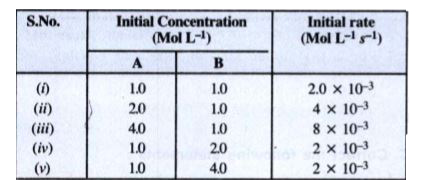For the chemical reaction A+2B→2C+D.
The experimentally determined information has been tabulated below:

for the reaction,
a)Calculate the order of reaction w.r.t. both the reactants A and B
b) Write the expression for rate law.
c) Calculate the value of the rate constant
d) Write the expression for the rate of reaction in terms A and C.
Text Solution
a) Calculation of order with respect to A and B
Let the rate law equation for the reaction be : rate = k[A]x[B]y
The rates for the four experiments may be written as:
0.96 = k[0.30]x[0.30]y
0.384=k[0.60]x[0.30]y
0.192=k[0.30]x[0.60]y
0.768=k[0.60]x[0.60]y
Dividing eqn (ii) by eqn. (i), we get
0.3840.96=k[0.60]x[0.30]yk[0.30]x[0.30]y or 4=(2)x
(2)2=(2)x or x=2
Dividing eqn. (iii) by eqn. (i), we get
0.1920.096=k[0.30]x[0.60]yk[0.30]x[0.30]yor4=(2)x
(2)2=(2)xorx=2.
Dividing Eqn. (iii)by eqn. (i), we get
0.1920.096=k[0.30]x[0.60]yk[0.30]x[0.30]y or 2 = (2)y
(2)′=(2)y or y=1
Order w.r.t. A= 2, B=1 ltrbgt Rate law expression , Rate(r) = k[A]2[B]1
c) Rate constant(k) = Rate(r)[A]2[B]2=0.0960.027=3.56
d) Rate of reaction in terms A and C, Rate = −d[A]dt=12d[C]dt
|
Topper's Solved these Questions
- CHEMICAL KINETICSBOOK - DINESH PUBLICATIONCHAPTER - CHEMICAL KINETICSEXERCISE - NCERT Exercise
1 Videos
- CHEMICAL KINETICSBOOK - DINESH PUBLICATIONCHAPTER - CHEMICAL KINETICSEXERCISE - NCERT in text questions
38 Videos
- CHEMICAL BONDING AND MOLECULAR STRUCTUREBOOK - DINESH PUBLICATIONCHAPTER - CHEMICAL BONDING AND MOLECULAR STRUCTUREEXERCISE - Unit Test - 1
20 Videos
- CHEMICAL THERMODYNAMICS AND CHEMICAL ENERGETICS BOOK - DINESH PUBLICATIONCHAPTER - CHEMICAL THERMODYNAMICS AND CHEMICAL ENERGETICS EXERCISE - Exercise
507 Videos
Similar Questions
Knowledge Check
The rate law for a reaction A+B→C+D is given by the expression k[A]. The rate of reaction will be
Adoubled on doubling the concentration of BBhalved on reducing the concentration of A to halfCDecreased on increasing the temperature of the reactionDunaffected by any change in concentration or temperature.The rate law for a reaction A+B→C+D is given by the expression k[A]. The rate of reaction will be
Adoubled on doubling the concentration of BBhalved on reducing the concentration of A to halfCDecreased on increasing the temperature of the reactionDunaffected by any change in concentration or temperature.
Derive an integrated rate law expression for first order reaction: A → B + C
View SolutionWrite the rate equation for the reaction 2A+B→C if the order of the reaction is zero .
View SolutionWrite the rate equation for the reaction 2A+B→C if the order of the reaction is zero .
View SolutionWrite the rate equation for the reaction 2 A+ B→C if the order of the reaction is zero.
View SolutionWrite the rate rate equatioin for the reaction 2A+B→C if the order of the reaction is zero.
View SolutionConsider the reaction, A+B→C+D.
The initial rate for different initial concentrations of the reactants are given below :

Calculate the rate constant.
View Solution
